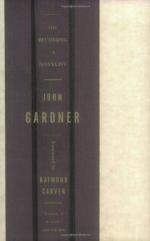
|
| Name: _________________________ | Period: ___________________ |
This test consists of 15 multiple choice questions and 5 short answer questions.
Multiple Choice Questions
1. What organization does Gardner suggest for help in locating good teachers, advice on fellowships, etc.?
(a) ACII.
(b) Poets & Writers.
(c) New Yorker.
(d) MFA programs.
2. Chapter 3 states that getting any letter at all from an editor is a mark of what?
(a) Interest.
(b) Luck.
(c) Quality.
(d) Ability.
3. In Chapter 3, Gardner writes, "One hears the complaint that conferences lead to a kind of writer ____."
(a) Sniveling.
(b) Ego-stroking.
(c) Incest.
(d) Promotion.
4. According to Gardner, most rejected fiction is rejected because it's not what?
(a) Good.
(b) Symbolic.
(c) Subversive.
(d) Modern enough.
5. Gardner writes in Chapter 3, "Young writers want to ____ because they're unsure of themselves."
(a) Publish.
(b) Go to school.
(c) Study.
(d) Read.
6. What teacher and poet is quoted as saying, "My object is to catch right now what will embarrass my students when they look at their poetry ten years from now"?
(a) Julia Roberts.
(b) Allen Ginsberg.
(c) Robert Frost.
(d) Dave Smith.
7. Gardner writes in Chapter 2 that in a bad workshop, the teacher takes the place of the student's what?
(a) Internal critic.
(b) Ability to think.
(c) Critical imagination.
(d) Assimilation.
8. Gardner compares the first thrill of achievement of the writer to that of an oboist or what?
(a) Painter.
(b) Pianist.
(c) Actor.
(d) Gambler.
9. Who does Gardner suggest writing to for information on reliable agents?
(a) NROP.
(b) ILAA.
(c) DRAA.
(d) AFJI.
10. Where does the manuscript go after the literary editor is finished with it?
(a) Copy editor.
(b) Publisher.
(c) Author.
(d) Typesetter.
11. What does Gardner cite as one of the most respected publishers of novels?
(a) Simon and Schuster.
(b) Alfred A. Knopf.
(c) Penguin.
(d) Harper and Row.
12. In Chapter 2, Gardner states, "A writer does not become better by being ____."
(a) Scorned.
(b) Adored.
(c) Beaten.
(d) Pandered to.
13. Who wrote The World According to Garp?
(a) John Irving.
(b) George Glass.
(c) Raymond Carver.
(d) Michael James.
14. Gardner states in Chapter 2 that an individual style is developed as much by resistance as by what?
(a) Emulation.
(b) Contortion.
(c) Malleability.
(d) Adjustment.
15. What is one of the great questions of the moment which is addressed in The World According to Garp?
(a) Environment.
(b) Race relations.
(c) Globalization.
(d) Feminism.
Short Answer Questions
1. What is the name of the writer's conference where Gardner has frequently worked with writing assistants?
2. What is one of the most important things for a young writer to have, according to Gardner in Chapter 2?
3. Which manuscript did Gardner send out which got a reply suggesting he cut it by a third?
4. What was William Gass publishing at New American Library?
5. To which editor at New American Library did Gardner send The Sunlight Diaries?
|
This section contains 429 words (approx. 2 pages at 300 words per page) |

|




